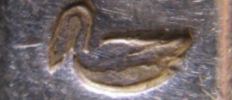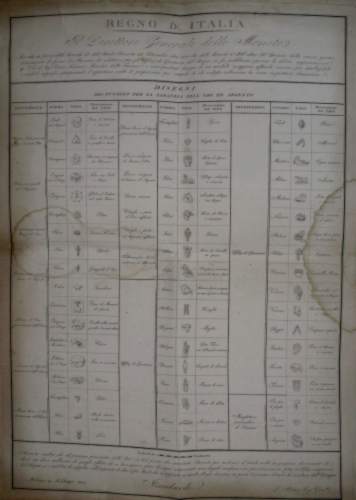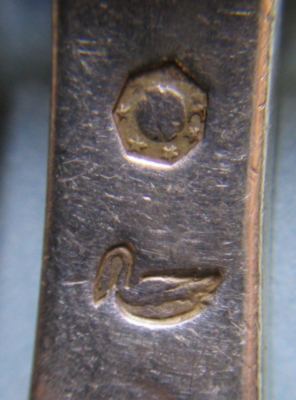by Franco
Negrini e Francesca Rapposelli
((click on photos to enlarge image))
SILVERSMITHING IN MANTUA FROM THE 14TH TO THE 19TH CENTURY
- part 2 -
In 1786 during the great political and
administrative reform that involved the whole structure
of Austrian Lombardy the ancient guilds of art were
abolished, but silversmithing was privileged, obtaining
special attention.
In Mantua special police measures were adopted by the
political intendant Gherardo d’Arco, who on September
25, 1787 asked Giovanni Bellavite (appointed
representative of silversmiths) to compile the new
regulations which actually confirmed most of the old
regulations of the Art.
Also the ancient marks were maintained at least until
1792 when the new representative of silversmiths, Giacomo
Antonio Bosio (Mantua 1722 - Mantua 1798), was authorized
to continue the practice of marking silverware with the
old symbols.
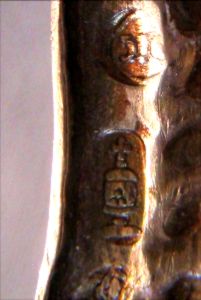
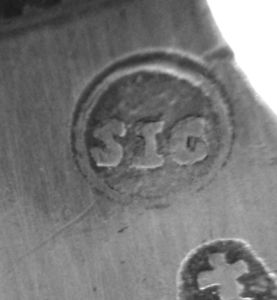 |
|
Ancient silver marks used in Mantua
before the new regulation introduced in
1786 by Austrian Government
|
On February 2, 1797 Mantua surrendered to
the French Army and, with the Treaty of
Campoformio, became part of the Cisalpine
Republic. In 1805 Napoleon was crowned King of
the new Kingdom of Italy and Eugenio Napoleon
Beauharnais settled as Viceroy in the Royal
Palace in Milan.
On December 25, 1810 a new system of rules for
the manufacture and trade of gold and silver
artefacts was approved by the Viceroy. The new
regulations, inspired by French laws, consisted
of 110 articles which imposed a system based on
three marks and new symbols were approved to
identify the quality of the metal alloy and the
Assay office location.
|
|
| |
Table of "Disegni dei Punzoni di
Garanzia dell'Oro e dell'Argento" (Drawings
of Silver and Gold Warranty Marks)
|
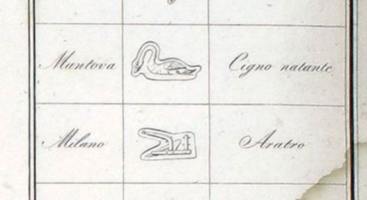 |
The new mark used to warrant the 800/1000
silver alloy was a heptagon containing the World
(or the globe) surrounded by the seven stars (or
trioni, from ancient Latin: triones) of the
Great Bear constellation.
The Mantua Assay Office was identified by the symbol
of a “Swimming Swan”, but with a new decree
dated 14 February 1812, only the offices of
Milan, Venice, Bologna, Ancona, Verona and
Brescia were activated … Mantua and its swan
were obliged to wait…
Mantua silversmiths were forced to present their
silverware to the Verona Assay Office, and, despite
numerous petitions, the request to activate the
Mantua Assay Office was rejected by Authorities.
Indeed, the difficulties grew in 1814, when the
second Austrian domination and redefinition of
boundaries obliged Mantua silversmiths to go even
further distances to obtain the assaying of
their products.
|
This situation had an influence on the number of
silversmiths’ active in Mantua and many of them
preferred to become silver and gold retailers trading
artefacts manufactured and marked by other workshops.
Scarce silver products with Mantua marks are locally preserved
and most early 19th century silver has Milan,
Brescia or Venice marks.
An example is this spoon with the globe (mondo and
trioni: silver fineness 800/1000), plough (Milan assay
office) and Gio Battista Sala workshop mark (GBS with
two crossed swords and crown).
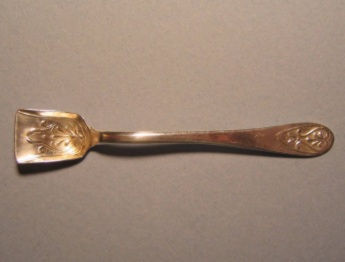
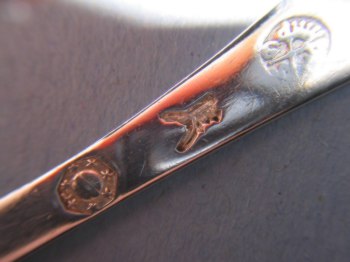 |
|
silver 800/1000 spoon with Milan
assay office mark and Gio Battista Sala
workshop mark
|
Also Brescia’s silver articles were imported in large quantities into Mantua, and this
assay office used the symbol of a "spear’s
top". An example is on the spoon manufactured in
Domenico Roveglia workshop bearing the mark with "DR and
tree" (note 1)).
In this case the "globe" is replaced by the "anvil",
used as "small items" fineness warranty.
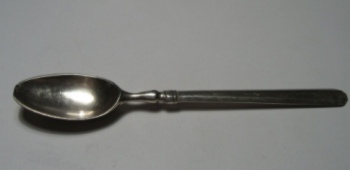
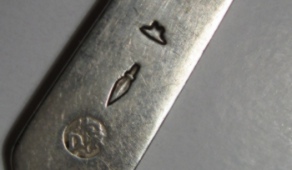 |
|
Silver 800/1000 spoon bearing Brescia
assay office mark and Domenico Roveglia
workshop mark. In this case the "globe" is
replaced by the "anvil", used as "small
items" fineness warranty.
|
The petitions of Mantua silversmiths obtained a
result only in 1831, when the local assay office was
opened and the "Swimming Swan" symbol was activated
(note 2).
Following these considerations, it’s reasonable to
suppose that most of the artefacts bearing only the
workshop mark were manufactured in the period 1810-1830.
An example is this spoon made by Mantua’s silversmith
Luigi Martelletti (1775 - 1852) marked only with "lamb
and cross" (emblem of St. John the Baptist) and letter
"M" (see for comparison the mark on the tag presented to
the assay office in 1811)
(note 3).
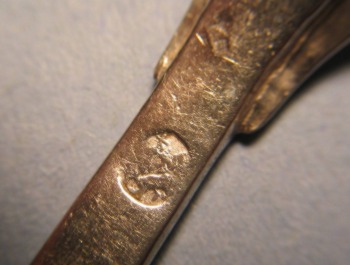
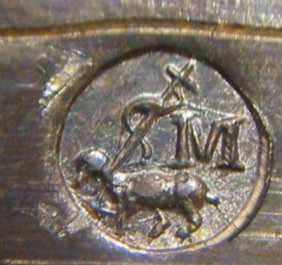 |
|
Silver spoon bearing only Luigi
Martelletti workshop mark (on the left the
mark on the tag presented to the assay
office in 1811).
|
Even the spoon bearing the "Swimming Swan"
is characterized by shape and decoration typical
of the first half of the 18th century.
This "violin" handle, markedly concave and
simulating a superimposed second stem, is
inspired to Venetian production, largely
followed by Mantua silversmiths.
The "double" stem ends with a stylized trefoil
contour
(note 4).
The stem is marked with the "Swimming Swan" and
the "globe", while the workshop mark is rubbed out.
The stem is also engraved with owner’s initials
"IAF".
|
|
 |
NOTE
(1) R. Massa, Orafi e
argentieri bresciani nei secoli XVIII e XIX, Brescia
1988, p 113
(2) The " Swimming Swan" mark
(introduced with the Royal Decree of 25 December 1810)
and the three marks system were repealed with the law
issued by the new Kingdom of Italy (unified) on May 2,
1872 (see V.Donaver-R. Dabbene, Argenti italiani
dell'800, vol.I Punzoni di Garanzia degli Stati Italiani
, Milan 1987, P. 14; and S. Barraja, I marchi
degli argentieri e orafi di Palermo dal XVII secolo ad
oggi, Palermo, 1996. Silvano Barraja's book reports
also the text of many laws and decrees regulating the
manufacture and trade of gold and silver items in Italy
from 1872 to present days).
(3) see F. Rapposelli,
Repertorio degli orefici mantovani. Maestri, botteghe e
punzoni dal XVII al XIX secolo, in d’Oro e
d’Argento, Castel Goffredo 2006, p. 178
(4) see F. Negrini,
Servizio di posate, in d’Oro e d’Argento,
Castel Goffredo 2006, p. 142
Franco Negrini and Francesca Rapposelli
- 2008 -
English version of this article translated by Giorgio Busetto
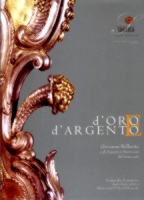 |
Francesca Rapposelli is the Curator of the
book "d'Oro e d'Argento - Giovanni Bellavite e
gli Argentieri Mantovani del Settecento" of
which Franco Negrini is a co-author.
The book was published for the Exhibition
sponsored by "Gruppo San Luca Onlus, Castel
Goffredo, (Mantua, Italy), from March 19 to June
18, 2006. In this book is also presented an
interesting directory of Mantua's Silversmiths
from the 17th to the 19th century
For information about this book, contact
Corrado Bocchi: bocchi@email.it
|
|
|
|
 ASSOCIATION OF SMALL COLLECTORS OF ANTIQUE SILVER
ASSOCIATION OF SMALL COLLECTORS OF ANTIQUE SILVER







